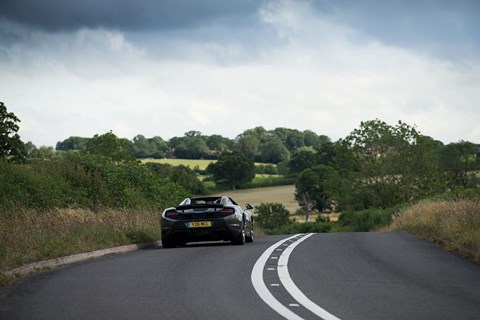► Seven months with a McLaren 650S Spider
► Can a supercar be a viable daily driver?
► The CAR long-term test review finds out
Month 7: the CAR magazine long-term test verdict
First McLaren, first convertible, first supercar. First time I had 641bhp on tap day-in, day-out. First time I’ve done 8.6mpg (Silverstone), 185mph (Silverstone) and my journey home in less than 20 minutes (not Silverstone). First time I’ve picked up the keys to anything in a place with orange ticks on the official stationary, Senna pictures on the walls and P1s ‘out back in the workshop’. First 650S Spider. Last 650S Spider. Balls.
Forgive me if you’ve never ridden a motorcycle, and particularly if you have no time for them, but the parallels between using this country’s road network on a bike and doing so in the McLaren 650S Spider were striking. It starts with the nest of nerves that erupts in your tummy when you start the thing.
Eighteen years since I passed my test and after perhaps 120,000 miles on all kinds of bikes in all kinds of conditions, firing one up still gives me the heebie-jeebies. (As well it should: few things in life are so unfailingly unforgiving).
The McLaren was the same. You can bound out of the house without a a care in the world, lift that door and drop into that perfectly sculpted seat thinking of everything and nothing all at once, of Scarlett Johansson, deadlines and towering pulled pork sandwiches. But the moment you push the starter that engine snaps you into the right here, right now. As well it should.
Then there’s the way in which the McLaren can so effortlessly bypass everything else on the road, as a motorcycle can. Your crushing performance advantage is to be used sparingly of course, but it is at once faintly scary and hugely relaxing. There’s never any need to feverishly plot safe overtakes based on a scant opportunity and a good run up, or to fall into lowest-common-denominator line behind that Honda Jazz.
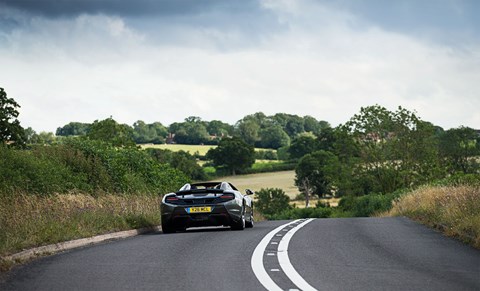
It takes time to acclimatise to the astonishing rates at which the McLaren can gain and lose speed, but to do so, and to reach the state in which you’re serenely slipping past everything else on the road so smoothly and courteously that it doesn’t even notice your passing, is to achieve a kind of nirvana. That you can do all of this without a roof, and invite in the world in all its multi-sensory glory, just ramps things up a notch: the smell before rain as you race home in the first drops of a summer evening downpour; the welcome chill as an August day finally cedes its heat with dusk.
So all was bliss? Largely yes, as you might expect of a car costing more than £200,000 (and nearer £250k optioned as ours was). Reliability was absolute. You might think that a given on such rarified machinery but it really isn’t. Comfort and practicality (and therefore versatility) – McLaren’s claimed USPs in this odd little corner of cardom – are impressive.
Where Lamborghini persists with seats that are agony to sit on and Ferrari with a firm emphasis on breathless stimulation and chaotic interior design, the McLaren is calm, comfortable and hugely capable. Turn things up and down via the Handling and Powertrain controls and the car responds emphatically, shifting from plush, quiet mile-eater (with exemplary ergonomics and great forward visibility) to hair-trigger circuit-basher.
That control system is too fussy – Ferrari and Porsche do it better with a rotary control on the wheel – and I still think the traction-control leash would be more intuitively governed by the Powertrain rather than the Handling control (I learnt the interesting way, with a generous kick sideways attempting a pass in the rain) but generally the McLaren’s interfaces are simple and effective. (The 675LT separates the anti-crash electronics from Handling, so you can enjoy the firmer dampers and weightier steering of Sport with the safety net in place).
Certainly I grew to love the luxuriously sparse cockpit: never has so little been so welcome and so nicely executed. Those cast aluminium levers! The gorgeous click of the one-piece paddleshifter! The rock-solid, LMP1-esque art of the throttle and brake pedals! I grew to love our car’s relatively understated external appearance too but it’s hard to argue that, at £11,200, orange brake calipers, a smattering of carbonfibre and Storm Grey special paint are essential. Had it been my car I’d have stripped things right back and plumped only for the Sports exhaust (terrifying under bridges at full chat) at £4790, the electric and heated memory seats (£2730) and the parking sensors (£1640).
The 650S is now the oldest model in the range, though given how rapidly McLaren is renewing and expanding its line-up, that’s not saying much. Certainly the 675LT and 570S have put the 650S under pressure, the former by ramping everything up a few notches to deliver a more potent hit, and the latter by undercutting the 650 on which it’s based for very little discernible loss of brilliance.
But that doesn’t in any way diminish the appeal of the 650S Spider, a car so relentlessly capable and seductively impressive that within a few hundred miles you do wonder how you’re ever going to get by without one. But go without one I must. Still, better to have loved and lost.
By Ben Miller

Count the cost
Cost new: £251,080 (including £35,560 of options)
Dealer sale price: £208,500
Private sale price: £202,995
Part-exchange price: £199,450
Cost per mile: 29p
Cost per mile including depreciation: £15.85
Logbook: McLaren 650S Spider
Engine: 3799cc twin-turbo V8, 641bhp @ 7250rpm, 500lb ft @ 6000rpm
Transmission: 7-speed auto with paddleshift, rear-wheel drive
Stats: 3.0sec 0-62mph, 204mph
Price: £215,520
As tested: £251,080
Miles this month: 714.7
Total miles: 3317.7
Our mpg: 15.9
Official mpg: 24.1
Fuel cost overall: £955.01
Extra costs: £0
Month 6 running a McLaren supercar: waste not, want not
Wednesday night, summer. Just gone 8pm, heading for the sofa. Blam – the thought hit like a sniper’s round: ‘It’s summer, you have a McLaren; drive.’ Three minutes later the V8 was awake, the roof dropped. Ten minutes later we were fast and free on deserted, still-warm roads.
An hour later I stopped for fuel. At the next pump an old mate I hadn’t seen for years, out on his superbike. We talked a while as the sun dropped from a sky of fire. Two hours later his text arrived: ‘Good drive home? I could still hear you three minutes after you left!’ Bug-smeared headlights, summer night in my eyes, drive of the year.
By Ben Miller
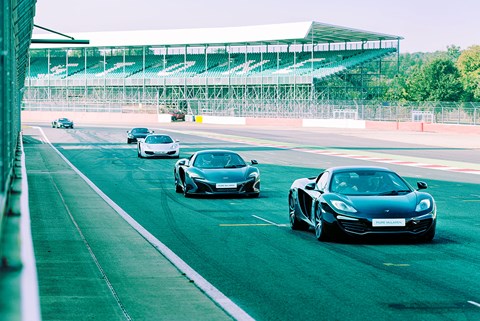
Month 5 running a McLaren 650S Spider: if McLaren did track days…
Google Maps won’t back me up on this but Utopia is a place on Earth, just off the A43 at Towcester. Certainly it was for one day last year, at one of McLaren’s Pure track events at Silverstone.
Since this was a day in the 650S Spider, the good stuff started the moment I left home on one of those bright, crisp mornings that spikes the hours after dawn with just enough chill to speed the waking up process, particularly when you’ve an 80-mile roof-down journey with 641bhp at your back. Not all that much later the good stuff continued with a trackday hospitality suite quite unlike any I’d previously enjoyed. Instead of instant coffee, a cold pit garage full of puddles and a shouty, Full Metal Jacket-style briefing, the gathered McLaren owners, present and future, enjoyed good espressos, even better bacon, PlayStations for a little pre-track sim work and a good-natured, funny welcome chat from Woking’s top in-house helmsman Chris Goodwin.
I assumed the day would run in sessions but after a handful of initial sighting laps Silverstone’s International circuit (tasty, but the layout that sadly hangs a right just before the mighty Maggots/Becketts complex to cut out half the full lap and re-join on the Wellington straight) was ours for the day, to drive as much or as little as we liked. More good stuff.
And then there was instructor Ray Grimes, on hand like a taller, less green Yoda to unleash my inner Alonso. Being male, I spent the morning disregarding the idea of taking any instruction and merrily understeering my way around the circuit on an unholy mess of lines no one else seemed to be taking. I was lost, adrift on a sea of ignorance and exuberance, and saved from drowning only by the McLaren’s assists. Where F1 drivers specialise in speed with consistency I had neither, that epic front-end scrub occasionally spiking into messy half-slides. Other 650Ss eased past. Bruno Senna (below), in a 675LT, howled past like I was stuck in first. Maybe there was room for improvement.
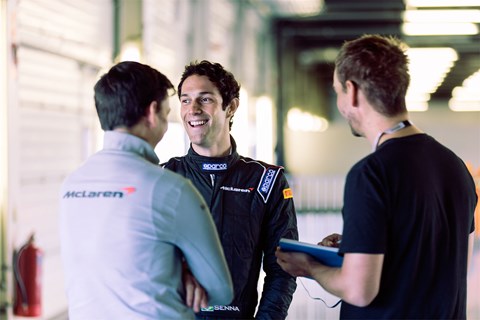
To be fair to Ray he stayed quiet for a whole lap, observing, biting his tongue and gently shaking his head. Then, with perhaps 25 spoken words, he changed everything. The Eureka moment was trail-braking, and much more of it. Previously I’d been timidly brushing the middle pedal (the McLaren only has two, but you know what I mean) on the way into corners, the legacy of too many years on motorcycles and their break-your-legs intolerance of too much combined turning and braking. Where I’d been braking hard in the McLaren but coming off the pedal before turn-in, and then wondering why, when I tried to turn, the nose-light 650S skated wide like a cat on greased tiles, Ray had me braking a little later and carrying much more brake pressure into each corner.
The understeer simply vanished. Tyres thumped encouragingly over rumble strips; entry, apex, exit. My confidence soared. Braking later meant more speed. Tidier lines meant more speed. Neater exits meant more speed. And the sensations were exquisite, particularly when I got the combination of steering angle, line and pedal pressure just right and the whole car, all 1600kg of carbon, Ben, Ray and twin-turbo V8, felt exquisitely agile, balanced like a spinning basketball on a finger.
As the day rolled on, the good stuff continued. The 650S’s fuel economy dropped into single figures. A mechanic checking my tyre pressures after a session found the valve caps too hot to remove, even wearing gloves, which I took to be a good thing. In the time between sessions I chatted with other Pure disciples, a passionate, gregarious bunch with wildly different objectives. Some were on their way to becoming fully-fledged GT race drivers. Others just wanted to get to know their McLaren better, and to explore its towering potential. A few didn’t own one yet, though their smiles suggested they soon would. One was running his privately owned ex-Mika Häkkinen MP4-16, the shrill majesty of its raging V10 a poignant reminder of an already forgotten pre-turbo era. All were having the time of their lives.
Pure events in 2016 include Spa-Francorchamps (4-5 April), Paul Ricard (10-11 May), Brands Hatch GP circuit (22-23 June), Hockenheimring (7 July) and the Silverstone GP circuit (7-8 September). For details visit puremclarenexperience.com
By Ben Miller
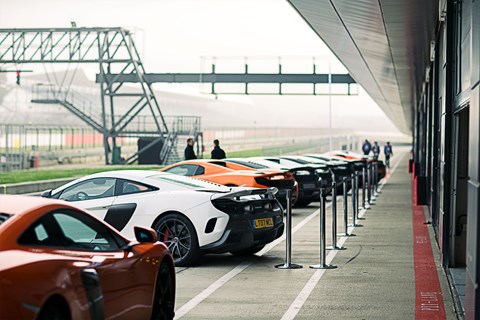
Month 4 running a McLaren supercar: poring over the details
Fine fundamentals – searing speed, a dazzling chassis – are almost a given. But the 650S’s little things are even better. Here we pore over some of the delectable details of our everyday supercar.
Versatile ceramics have it all covered

You expect discs, calipers and hydraulics with the power to equal the V8’s limitless reach, but what’s striking is the carbon-ceramics’ calibration and all-weather usability. At one extreme their feel, strength and subtle ABS software let you nibble away at your braking points at Brands. At the other, the 650S stops from walking pace without a jolt. Pedal itself worthy of an F1 car. Orange calipers just £910.
An engine for every occasion

No oil consumption in 2000 miles, smoother than waxed water from cold and capable of traffic-clearing overtakes in a heartbeat. Lacks the visual or aural appeal of a Ferrari V8 but the swell of boost, when it arrives, doesn’t want for drama. Twin-clutch gearbox a joy whether in automatic or manual mode, though pulling both paddles for neutral would be easier than prodding a button. 19.5mpg limits range and disposable income.
The important stuff and nothing else

Steering wheel simply the best there is – odd at first grasp, then so good everything else feels forever wrong. Enormous central rev counter gives you a fighting chance of keeping up. Stalk on the left gets you into the sub-menus, including settings and tyre pressures. Clever shortcut – hold the lever up for a second – for raising the suspension (all round remember, not just the front) is a great detail. Second-gen IRIS interface nicely slick.
Boot space to shame an MPV
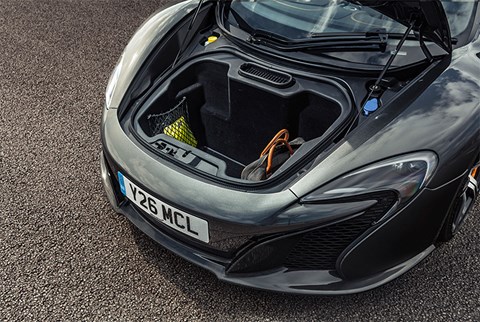
Perhaps not, but the 650S’s big front luggage compartment – generous enough for a second passenger if needs must – has room enough for cases, bags, jackets, tweed and fascinators (well, it was Goodwood Revival). Spider lacks the Coupe’s handy shelf behind the seats but hits back with the tonneau compartment, that – with the roof up – lets you stash more gear in the space the car would use for the roof were it folded away.
By Ben Miller
Month 3 running a McLaren 650S Spider: track and touring, ticked and ticked
A couple of unforgettable consecutive days brought the McLaren’s versatility into focus. On the Thursday, a Pure track day at Silverstone. More on this later but suffice to say the 650S, with its assists pegged back but not switched off and its twin-turbo V8 savaging anything resembling a straight, was an awe-inspiring ally. And the next morning two of us, together with an unfeasible number of bags, cruised to the Goodwood Revival, enjoying the McLaren’s immaculate road manners.
By Ben Miller
Month 2 running a McLaren 650S: a real multi-purpose vehicle?
Life with a McLaren 650S Spider inevitably involves giving plenty of passenger rides. Obliging could hardly be described as a chore, and can prove useful for finally silencing family members previously convinced that their Alfa Mito is ‘a rocket ship’.
Any true supercar must be able to impress in this scenario – talk of advanced composites counts for nothing if a car can’t render a ten-year-old boy hysterical. And I had worried for the McLaren on this score, largely because the last supercar I was fortunate to spend any real time with – CJ’s Lamborghini Huracan – might have been crafted from the wheels up with impressing passengers as its driving design objective, hence the wild styling, banshee V10 and lime green seats.
I needn’t have worried. Our Spider may be stealth of paint, rendered as it is in dark Storm grey, but the orange calipers and diamond-cut wheels work to dramatic effect against the car’s menacing form. The McLaren seems just as capable at invoking silent awe as any Lamborghini. The doors help. The lack of an obvious handle delights newcomers, as does the effortless way in which each one hisses up like a butterfly wing on its strut. A true supercar must have event doors. Front-hinged and outward-opening? Please.
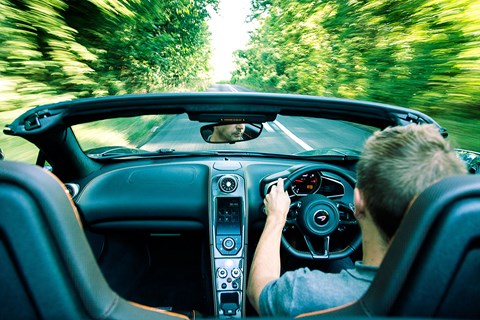
Once aboard the twin-turbo V8 yelping into life ramps up the anticipation nicely, as does dropping the roof. The next few minutes have now begun to adhere to a script of sorts. Passenger expresses delight at the quality and design of the cabin, coos at seats, then plays with nearest air vent (which look identical to those used on McLaren’s F1 pitwall ‘office’, though in the 650S they ventilate a far happier environment). Throttle goes to the full extent of its travel for perhaps three seconds. Passenger goes silent, grasps handle. 650S negotiates corner or roundabout at speed without roll, protest or incident. Passenger grunts, then starts laughing as the car’s speed drops back to normal and the McLaren reverts back to its plush-riding, auto-shifting best-behaviour.
And the rest of the time, when you’re on your own, the 650S shines with a deeply satisfying brilliance across an impressively broad operating window. On dry roads you know well it’s predictably accomplished, effortlessly eclipsing any previous personal bests you have set with its blend of any-rev thrust, mighty grip, fantastic steering and wickedly strong brakes. It’s just as engaging in the streaming wet too, the multi-level traction and stability systems allowing you to explore the available grip in complete safety. The deft damping and communicative, encouraging steering also swell your confidence. For me the car’s at its best on wet roads, rear window dropped to better hear the engine and the underbody aero flinging a vast GT3-style wake into the atmosphere behind you. The only snag in such conditions is that because the stability systems are linked to the Handling mode, switching to Sport, for its firmer damper set-up and weightier steering, also slackens the electronic leash. There’s a logic there of sorts, but it’s interesting to note that on the 675LT McLaren has decoupled the two.
And if you’ve a couple of hundred miles of ground to cover on more mundane roads the 650S is no less capable; refined, comfortable and shot-through with an intangible but ever-present sense of special-ness. Set the chassis to Normal, the gearbox to Auto and the DAB radio to talkSPORT, pop a Starbucks in the cup holder and you’re ready for any journey, even the kind of four-hour stints that have Huracan pilots grumbling.
By Ben Miller
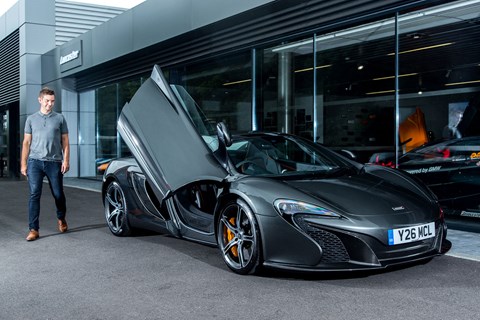
Month 1 running a McLaren 650S Spider: the introduction to our long-term test
You have to hand it to them, they’re good. You could step from your train at Ascot station, stroll the 50 yards between the platform and the UK’s latest McLaren dealership and step through the door completely indifferent to Britain’s pre-eminent supercar maker, but five minutes later you’ll be considering a McLaren Qualified (approved used) 12C, buying the subtly branded weekend bag to slip into its nose and mentally re-decorating the garage at home with Can-Am orange walls, a print of Senna at ten-tenths in his MP4/4 on the wall and a polished stone floor so flawless Ron could check his hair in it.
Surreally I’m here to pick up a 650S Spider, mine for the next six months, but so distracting is this shrine to Bruce’s fast car legacy that I fear a half-hour job is going to consume the day. Opened earlier this year, McLaren Ascot glows with the same purposeful ambition evident in the Woking firm’s plans for global supremacy. Not all that long ago the 12C was the company’s first wholly McLaren car since the F1. In the four years since the 12C’s launch we’ve had a beautifully judged evolution, 650S, a couple of game-changing hybrid hypercars, P1 and P1 GTR, and more recently the awesome 675LT and aggressively priced 570S. At Ascot the team’s straining at the leash; evangelical about the product, keen to provide the kind of service the cars deserve and fired up by the new era of increased volume 570S will usher in.
Of course there’s time for a little of the past alongside the future, and at Ascot it’s all there in an artful collection of prints above the coffee table. The ’95 Le Mans-winning F1 GTR. Prost and Senna in Marlboro red and white at Monaco. The raging Can-Am cars. Fittipaldi’s Texaco M23. The Yardley M19. A monochrome shot of Lauda and Dennis on their way to the ’84 driver’s title with the MP4/2. The images speak of a glorious racing past, of enigmatic drivers, wondrous cars and sheer read-it-and-weep statistics. Stuff like eight constructor championships and 12 drivers’ titles in Formula One and an outright Le Mans win, with a GT car, at the first time of asking. An example of the remarkable F1 GTR sits in the showroom, an outrageously liveried pink-and-black Lark-sponsored car, part of the squad that brought home in the bacon in the ’96 All Japan Grand Touring Car Championship. Window displays come no more magnetic.
Outside sits the Qualified stock, a rainbow range of 650S and 12C coupes and Spiders, with prices from ‘just’ £125,000. Qualified cars are inspected and prepared by McLaren technicians, sold with a 12-month warranty (you can upgrade to 24 months) and run the latest software upgrades. McLaren released several in the wake of the 12C’s initial launch, boosting power (from the original 12C coupe’s 592bhp to the Spider’s 617bhp across both variants), delivering a more intuitive and reliable version of the IRIS interface and bringing the 650S’s active aero functions to the 12C’s airbrake (auto-DRS at throttle openings of 80% or more, and angle adjustments to help stabilise the car when cresting sharp rises or braking hard). A 2012 12C coupe in McLaren orange catches my eye, at £126,950. I’dstruggle to raise a tenth of the asking price but, given the 12C’s rarity at fewer than 5000 units worldwide, and its importance as the first car of McLaren’s post-F1 renaissance, used buys surely come no smarter.
From the showroom a widescreen window lets you peek into the workshop, which is every bit as clean and as ordered as you’d imagine. Today – and I’m assured they’re not just for our benefit – not one but two P1s sit ready for expert attention. Ascot’s aftersales manager and hugely experienced McLaren spannerman Ben Bradford is as happy elbows-deep in a hybrid P1 as he is in the BMW-powered F1, which Ascot also service from time to time. Up on another ramp a 12C undergoes a routine service, its drag-cheating fully faired floor clear to see. And there, undergoing final checks, is our 650S Spider.
Despite the distractions, I spot it immediately. And while I’d love to be able to say I play it cool as a cucumber, acknowledging the car with a polite smile before getting down to the paperwork with sales executive Pete Sanderson, the truth is my face lights up like I’ve just been dealt a royal flush, my heart thuds in my chest like a cricket bat in a washing machine and my imagination immediately vaults ahead to a summer of roof-down bliss, sun-kissed trackdays and the higher state of being that comes with using a machine of such prodigious talent as an everyday tool.
Paperwork signed, it’s out to the car for a briefing. Gone is the 12C’s Jedi hand-swipe door release, replaced by an altogether easier, if less theatrical, rubber button. Up lifts the butterfly door on its perfectly judged strut and in I slide, getting comfortable in a car I’ll soon be hopping in and out of as a matter of routine. Wide sills mean there’s an art to roof-up entry, but getting in and out with the roof open is as easy as dropping into a 641bhp bathtub.
Pull the door shut, tug on the smaller stalk beneath the indicator for comfort entry and the seat whirs back into position. Far from feeling cool and standoffish, the cockpit’s beautifully hewn minimalism is welcoming. The steering wheel is free of buttons. Behind it the cast metal indicator lever and gearshift paddle are delightfully cool and solid to the touch. The IRIS system is as intuitive as its screen is clear. With faultless logic, each occupant gets their own climate controls, on their respective door. And on the centre console you’re drawn to the Active Dynamics panel, the key to the 650S’s versatility. Start the car and Active Dynamics default to the Handling and Powertrain to Normal, the safest of the three settings, regardless of the position of the switch. Push the Active button and the three-position switches go live, as do the Aero (activates the rear wing/airbrake’s active aero) and Manual buttons (switches from auto shifting to manual) within them. Semi-recumbent in the beautifully contoured seats, elegant wheel rim grasped in sweaty paws, this finally feels real.
Running the 650S for six months is the McLaren’s shot at righting a few wrongs. The car launched to critical acclaim and very nearly won our sports car giant test last year. In the final reckoning the 650S Spider claimed bronze, losing out to the Porsche Cayman GTS’s unrivalled value for money and the Ferrari 458 Speciale’s raw, heart-rending brilliance. But the judges raved about the McLaren’s broader remit, its Lotus-esque ride and handling and its mighty torque-rich twin-turbo engine. No-one would dream of running a 458 Speciale as an everyday car, but with its greater refinement, flawless ergonomics and versatile Proactive suspension, the 650S promises to be a supercar you can use like a supermini. Testing that promise is going to be quite a privilege.
With the Nav set to a tasty but ludicrously circuitous route home I click into first and, with a blare of rich V8 noise, pull gently onto the road and into an ordinary Monday afternoon, the McLaren at once as civilised as a Mercedes and as special as a Veyron. I could be very happy here.
By Ben Miller
